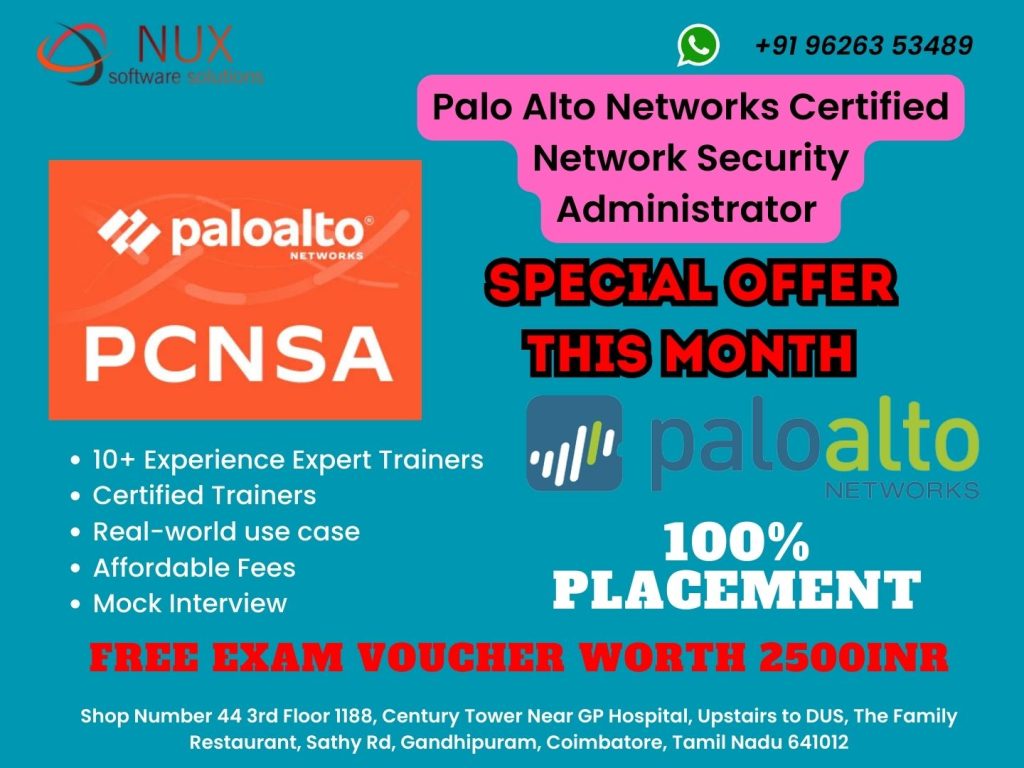Prisma Certified Cloud Security Engineer

Course Summary
The Prisma Certified Cloud Security Engineer (PCCSE) course is designed to validate the knowledge and skills required to secure cloud environments using Palo Alto Networks’ Prisma Cloud platform. This course focuses on protecting cloud-native applications across the entire development lifecycle—from build to runtime—across AWS, Azure, GCP, and hybrid environments.
Participants will learn how to deploy, configure, and manage Prisma Cloud to enforce compliance, detect threats, and automate security across containers, serverless architectures, and cloud infrastructure.
This course prepares you for the PCCSE certification, a globally recognized credential for cloud security professionals.
Why Choose This Course
With cloud adoption on the rise, so is the complexity of securing multi-cloud environments. Organizations are increasingly looking for professionals who understand both cloud infrastructure and modern cloud-native security. Prisma Cloud is among the most widely used Cloud-Native Application Protection Platforms (CNAPPs).
This course offers:
Comprehensive coverage of real-world cloud security scenarios
Hands-on lab environments simulating multi-cloud threats and policies
Instructors with industry experience in cloud security and DevSecOps
Aligned with the official PCCSE exam objectives
Ideal for professionals from Linux, DevOps, Security, or Cloud Engineering backgrounds
Who Should Enroll
This course is perfect for:
Cloud Security Engineers and Architects
DevOps and Site Reliability Engineers (SREs)
Security Operations (SecOps) and Compliance Teams
Cloud Administrators (AWS, Azure, GCP)
Professionals preparing for the PCCSE certification
Linux and network professionals transitioning into cloud security
What You Will Learn
By the end of the course, you’ll be able to:
Understand Prisma Cloud architecture, deployment models, and capabilities
Protect cloud workloads across containers, Kubernetes, VMs, and serverless functions
Configure policy rules for compliance (CIS, GDPR, PCI-DSS, etc.)
Monitor and alert on misconfigurations, vulnerabilities, and runtime anomalies
Automate remediation using integrations with CI/CD pipelines and ticketing systems
Perform risk assessments and cloud asset inventory management
Use the Prisma Cloud Console, APIs, and CLI for operational efficiency
Investigate security incidents using logs, alerts, and audit trails
Skills You Will Gain
Cloud security architecture and governance
Cloud-native workload protection (CSPM + CWPP)
Compliance reporting and security policy management
CI/CD integration for DevSecOps workflows
Multi-cloud visibility and threat intelligence
Real-world cloud security operations and response
Career Benefits
By completing this course, you will be qualified to:
Work as a Cloud Security Engineer, Cloud Risk Analyst, or DevSecOps Specialist
Design and implement secure cloud environments in AWS, Azure, and GCP
Take and pass the PCCSE certification exam
Boost your resume with high-demand skills in cloud security
Prepare for advanced certifications like CISSP, CKA, or AWS Security Specialty
Take Charge of Cloud Security – Start Today
Get the skills, certification, and confidence you need to secure any cloud environment with Prisma Cloud. With hands-on labs, expert mentorship, and real-world scenarios, this course will set you apart in the cloud security space.
Seats are limited. Enroll today.
Course Syllabus
Modules
Cloud Security Posture Management (CSPM) - 21%
- Inventory of resources in a cloud account
- Resource configuration history
- Asset configuration changes
- Custom policies
- Policy types
- Supported variables within configuration-run custom policies
- Standards
- Reports
- Alert states
- Alert rules
- Alert notifications and reports
- Alert workflow
- Inbound and outbound notifications
- Resource configuration with RQL
- User activity using RQL
- Network activity using RQL
- Anomalous user events
- Asset details using RQL
- Auto-remediation
- Manual versus automated remediation
- Internet-connected assets by source network traffic behavior
- Components
Cloud Workload Protection (CWP) - 21%
- Options available in the Monitor section
- Options available in the Policies section
- Options available in the Monitor section
- Options available in the Policies section
- Options available in the Monitor section
- Options available in the Policies section
- Options available in the Monitor section
- Options available in the Policies section
- Container models
- Host observations
- Runtime policies
- Runtime audits
- Incidents using Incident Explorer
- Monitor
- Policy
- Auto-protect
- Application specifications
- API methods
- Rest API endpoints
- DoS protection
- Access control to Limit inbound sources
- Network lists
- Access control to enforce HTTP headers and file uploads
- Bot protection
- Rules
- Audit logs
- Scanning
- CI
Install, Upgrade, and Backup / Prisma Cloud Administration - 19%
- Prisma Cloud release software
- Console in Onebox configuration
- Upgrade on Console
- Business use case to determine Prisma Cloud version to use
- Tenant versus Scale projects
- Types
- Networking for Defender-To-Console connectivity
- Upgrade and Compatibility
- Agent versus Agentless
- Cloud discovery
- Backup management
- Disaster recovery
- Certificates
- Secrets and credentials store
- Onboard cloud accounts
- Account Groups
- Users, roles, and permission groups
- Access control troubleshooting
- Service accounts and access keys
- Single Sign On
- Role-based access control for Docker Engine (CWP)
- Admission control with Open Policy Agent (CWP)
- Resource lists and collections
- Audit logging
- Defender logging
- Anomaly settings
- Idle timeout
- Auto-enable policies
- Alert dismissal reason
- User attribution
- Licensing
- Access key maximum validity
- Inbound and outbound notifications
- Supported capabilities
- Authenticate with APIs
- API documentation
- Policies and custom queries by API
- Alerts and Reports using APIs
- Vulnerability results via API
- Access keys
- Data security and IAM APIs
- Notification rule
- Adoption Advisor guidance
- Knowledge Center
- Help Center
- Feature requests
- PCCSE
- Live Community
- Product status updates
- Docs, Prisma Cloud Privacy and Support options
Cloud Network Security and Identity-Based Microsegmentation Enterprise Edition - 11%
- Network exposure policy
- RQL
- Processing units
- Namespaces
- Tags and identity
- Network rulesets
- Application profiling
- Types
- Networking for Enforcers-to-Console connectivity
- Flows
Prisma Cloud Code Security (PCCS) - 12%
- Terraform and Cloudformation scanning configurations
- OOTB IAC scanning integrations
- API scanning
- IAC scanning integration
- Supply-chain security
- Handling scanned issues
- Repository scanning
- OOTB policies
- Custom build policies
- Types of config policies
- Prisma configuration files
- Default CI policies
- Custom CI policies
- Code reviews
- Code repository settings
- Notifications
- Pull requests and tagging bots
Identity and Access Management (IAM)/Prisma Cloud Data Security (PCDS) - 16%
- AWS calculation
- Azure calculation
- RQL queries
- IAM policies
- Azure active directory
- Okta
- Manual versus automatic
- AWS remediation
- Azure remediation
- Monitor Scan Results
- Data Inventory
- Resource Explorer
- Object Explorer
- Exposure Evaluation
- Data policy vs data pattern
- Alerts
- Scan configuration
- Data profile and pattern
- File extensions
- Snippet masking



